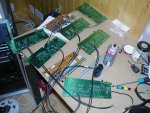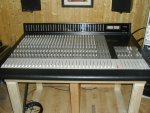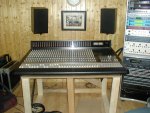miroslav
Cosmic Cowboy
I've never removed ALL the guts from my 3500...but I've had some of the 4-channel modules out...and all the faders...and even the master section.
Yeah...all those small connectors are a PITA...but I've yet to experience any signal drop/loss at the actual connections.
I think I had a loose connection at the headphone jack card once, and I just bent the pins a bit to snug up the connector.
I have also at one time disconnected ALL of them, applied some cleaner/conditioner, and then put them back, and it's all working fine all this time.
That's why I'm puzzled when I see guys like you who have just a whole slew of simultaneous issues.
I can only conclude that the previous owners of those very troubled 3500/3700 boards went out of their way to abuse and not ever maintain their boards.
I bought some spare modules/parts once from an guy who decided to part his out...and man, the surfaces alone had this grimy/sooty crud on them, and all the knobs were nasty dirty...etc....so I think I'm right...some people just don't appreciate an audio piece of gear like the rest of us do, and they beat the piss out of it until it develops problems, and then they get rid of it.
Yeah...all those small connectors are a PITA...but I've yet to experience any signal drop/loss at the actual connections.
I think I had a loose connection at the headphone jack card once, and I just bent the pins a bit to snug up the connector.
I have also at one time disconnected ALL of them, applied some cleaner/conditioner, and then put them back, and it's all working fine all this time.
That's why I'm puzzled when I see guys like you who have just a whole slew of simultaneous issues.
I can only conclude that the previous owners of those very troubled 3500/3700 boards went out of their way to abuse and not ever maintain their boards.
I bought some spare modules/parts once from an guy who decided to part his out...and man, the surfaces alone had this grimy/sooty crud on them, and all the knobs were nasty dirty...etc....so I think I'm right...some people just don't appreciate an audio piece of gear like the rest of us do, and they beat the piss out of it until it develops problems, and then they get rid of it.


 ) I'm going to plug things in and see what gives for a bit.
) I'm going to plug things in and see what gives for a bit.





